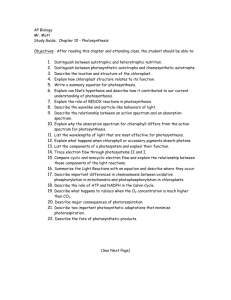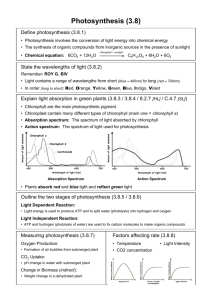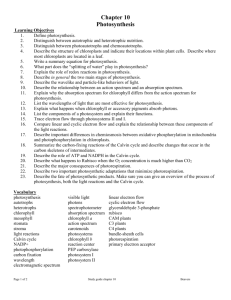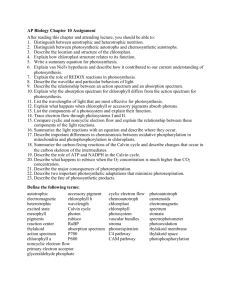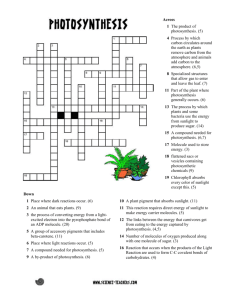AP BIOLOGY Chapter 10
advertisement
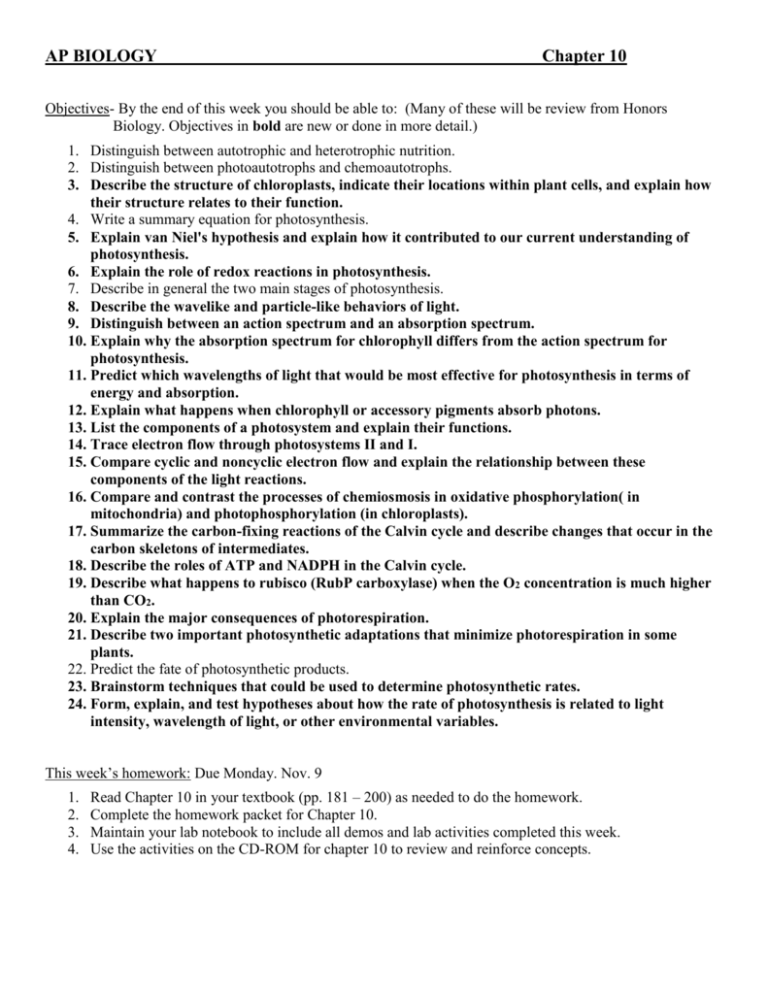
AP BIOLOGY Chapter 10 Objectives- By the end of this week you should be able to: (Many of these will be review from Honors Biology. Objectives in bold are new or done in more detail.) 1. Distinguish between autotrophic and heterotrophic nutrition. 2. Distinguish between photoautotrophs and chemoautotrophs. 3. Describe the structure of chloroplasts, indicate their locations within plant cells, and explain how their structure relates to their function. 4. Write a summary equation for photosynthesis. 5. Explain van Niel's hypothesis and explain how it contributed to our current understanding of photosynthesis. 6. Explain the role of redox reactions in photosynthesis. 7. Describe in general the two main stages of photosynthesis. 8. Describe the wavelike and particle-like behaviors of light. 9. Distinguish between an action spectrum and an absorption spectrum. 10. Explain why the absorption spectrum for chlorophyll differs from the action spectrum for photosynthesis. 11. Predict which wavelengths of light that would be most effective for photosynthesis in terms of energy and absorption. 12. Explain what happens when chlorophyll or accessory pigments absorb photons. 13. List the components of a photosystem and explain their functions. 14. Trace electron flow through photosystems II and I. 15. Compare cyclic and noncyclic electron flow and explain the relationship between these components of the light reactions. 16. Compare and contrast the processes of chemiosmosis in oxidative phosphorylation( in mitochondria) and photophosphorylation (in chloroplasts). 17. Summarize the carbon-fixing reactions of the Calvin cycle and describe changes that occur in the carbon skeletons of intermediates. 18. Describe the roles of ATP and NADPH in the Calvin cycle. 19. Describe what happens to rubisco (RubP carboxylase) when the O2 concentration is much higher than CO2. 20. Explain the major consequences of photorespiration. 21. Describe two important photosynthetic adaptations that minimize photorespiration in some plants. 22. Predict the fate of photosynthetic products. 23. Brainstorm techniques that could be used to determine photosynthetic rates. 24. Form, explain, and test hypotheses about how the rate of photosynthesis is related to light intensity, wavelength of light, or other environmental variables. This week’s homework: Due Monday. Nov. 9 1. 2. 3. 4. Read Chapter 10 in your textbook (pp. 181 – 200) as needed to do the homework. Complete the homework packet for Chapter 10. Maintain your lab notebook to include all demos and lab activities completed this week. Use the activities on the CD-ROM for chapter 10 to review and reinforce concepts. DATES TO REMEMBER: Monday. Nov. 9 – Homework Packet for Chapter 10 is due. Tuesday, Nov. 10 – Deadline for completing both Word Root quizzes (Chapters 2-5 and 6-8). (before school, after school, or DLT – at your convenience). THIS IS THE LAST DAY OF THE QUARTER SO THIS DEADLIND IS FIRM! Friday, Nov. 13 – Test on Chapters 9 & 10 (in class portion) Friday, Nov. 13 – Take home portion of Test for Chapters 9 & 10 due (this will be handed out Tuesday, Nov. 10) BIOLOGY HIT SONGS OF THE WEEK Photosynthesis (to the tune of The Muppet Song) The plants are making glucose. It’s happenin’ in the leaves! And in the plants when sunlight hits It’s photosynthesis! They’re using six CO2. Add in six H2O’s, Chlorophyll in just the right dose – Making a glucose! It’s C6H12O6, A simple sugar brew With energy to use Now transpirate the six O2. The plants are making glucose. It’s happenin’ in the leaves! And in the plants when sunlight hits It’s photosynthesis! Photosynthesis (to the tune of Auld Lang Syne) When sunlight bathes the chloroplast, and photons are absorbed The energy's transduced so fast that food is quickly stored, Photosynthetic greenery traps light the spectrum through Then Calvin cycle machinery fixes the CO2. Two chlorophylls (a, b to you) are cleverly deployed In photosystems I and II, within the thylakoid System I takes energy, at 700 (red) While system II (with pigment b) takes 680 instead.

